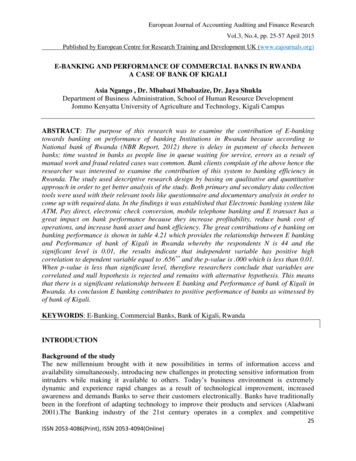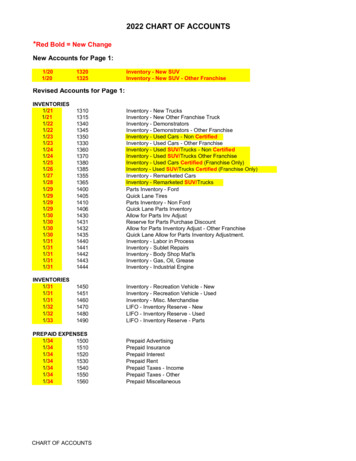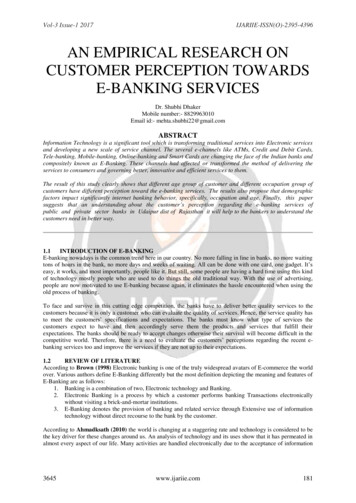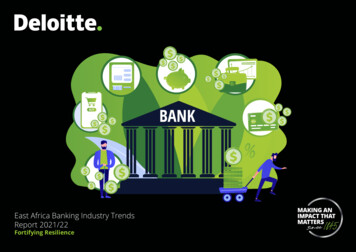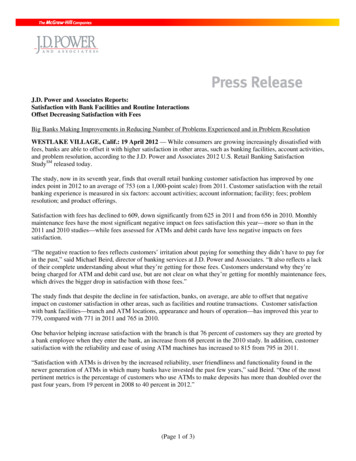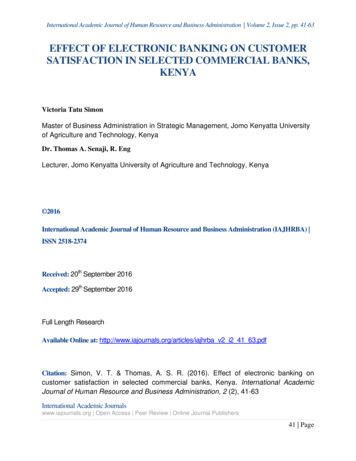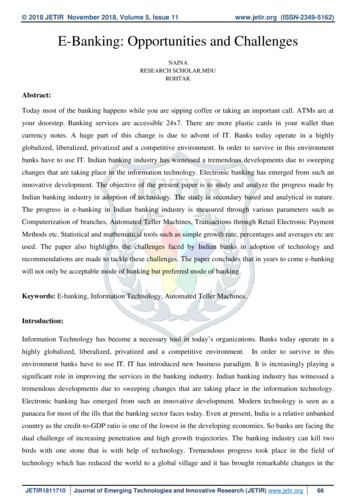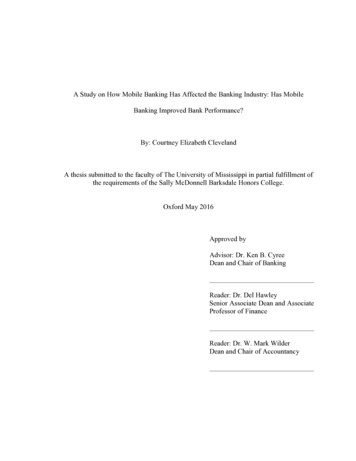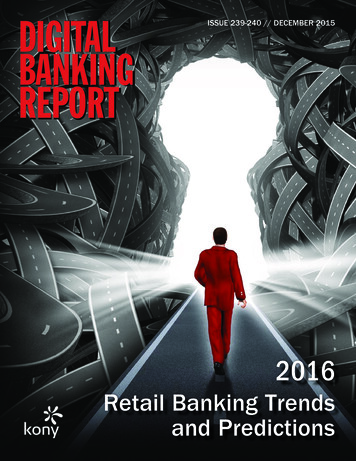
Transcription
ISSUE 239-240 // DECEMBER 20152016Retail Banking Trendsand Predictions
“2016 will be a year of execution, as a number of big trendsbegun in the 2008 recession move mainstream such as mobiledelivery, P2P lending, robo-advising, biometrics, etc. I also expectthe large financial brands to roll-out formidable solutions, oftenpowered by the very upstarts bent on disrupting them.”— Jim BrueneEditor and Founder of FinovateCopyright 2016: DIGITAL BANKING REPORT (ISSN 2375-3455)is published by DBR Media LLC, 8803 Brecksville Rd.,STE 7-223, Brecksville, OH 44141, USA. Phone: 1 (216) 218-4257admin@digitalbankingreport.com.Issue 239-240 Cost 495Subscriptions: US 1,695 per year worldwide includeselectronic editions with online archive access.Team and Enterprise subscriptions also available here.Publisher: Jim Marous, jmarous@digitalbankingreport.comGraphic Designer: Carol Ann RyanCustomer Support and Circulation: Jim BoothWARNING: Federal copyright law prohibits copying or distributing thisreport in part or in its entirety. ( 2016) This report is licensed forONE PERSON unless a multi-user subscription has been purchased.Contact jmarous@digitalbankingreport.com for additional licenses.PAGE 2
Letter from the PublisherDIGITAL BANKING REPORTJim Marous, Publisherjmarous@digitalbankingreport.com8803 Brecksville Road, Suite 7-223Brecksville, OH 44141(216) 218-4257Issue 239-240 Cost 495SUBSCRIPTIONS: 1,695 per year fordigital edition and online archive access. 2,995 for teams of 10. 9,995 for enterprise subscriptionsWARNING: Federal copyright law prohibitscopying or distributing this report in part orin its entirety. ( 2016) Contact jmarous@digitalbankingreport.com for reprints.More than ever before, all of the bankingindustry's constituencies are being impactedby the transformation of the banking industry.The category that has the most to gain fromthe changes expected in 2016 will be theconsumer. They are not only in the driver'sseat with regards to being able to voice theirdigital banking expectations, but there aremore firms than ever trying to meet thoseexpectations.As banking organizations further digitize theirofferings, the consumer will benefit. In 2016,we will see end-to-end digital account openingand onboarding solutions, contextual offers,better pricing that reflects the economiesfrom digital transformation, and a greater array of offerings coming from the partnershipof fintech and legacy banking organizations.We expect to see this wave of enhanced consumerism continue for the next several years.As margins get squeezed, competition intensifies and the government opens the door fora free market banking system, the bankingindustry will be in a constant state of flux.For the fifth consecutive year, we have surveyed a panel of close to 100 global financialservices leaders for their thoughts around upcoming retail banking and credit union trendsand predictions. The crowdsourced panelincludes bankers, credit union executives,industry analysts, advisors, authors and fintech followers from Asia, Africa, North America, South America, Europe, and Australia.These exclusive interviews were combinedwith in-depth analysis, charts and case studies around each trend to make up this year’sRetail Banking Trends and Predictions report.This is the most comprehensive analysis ofannual projections in the banking industry.We would like to thank Kony, Inc., who sponsored this year’s report development anddistribution. Their partnership enabled us toreach more industry gurus and compile morestatistics than ever before.Last year’s report proved to be highly accurate, with significant advancements indigital delivery, mobile design, the use ofanalytics, innovation and customer experience. Our expert panel was a bit toooptimistic, however, with their projectionsregarding mobile payments, industry consolidation and contextual engagement.We hope this year’s projections are helpfulwith your planning process.Jim MarousPublisher, Digital Banking Report2016 RETAIL BANKING TRENDS AND PREDICTIONSPAGE 3
UEISS1-23230//EROBOCT420134 //3-2E 23ISSU015CH 2MARISSUE 232 // JANUARY 2015ISSUE 238 //SEPTEMBER 2015ngnni lizing s:alPa Clsiecki heDigital Bankinggic : Criacpkitso m2015eting t nandPredictionsStrarativeBl’Bs uPirlTrendsda T ch Mobre igitaBplahe BIm n Dattle ile WaDigitolletsfor T“In-depth researchon how banksand credit unionsare changing.”op-of-MindSUBSCRIBE TODAYAnd save over 3,000compared to buyingindividual reports!Order your subscription today and receive12 issues of the Digital Banking Report forless than 200 an issue! Also enjoy accessto over 150 previous reports in our onlinelibrary. Don’t miss this opportunity!ISSUE 239-240 // DECEMBER 2015UPCOMING ISSUES 2016Retail Banking Trendsand Predictions2016 Financial Marketing TrendsThe Best Mobile Banking AppsPersonalization and Contextual EngagementDigital Money Managementdigitalbankingreport.com/subscribe2016 RETAIL BANKING TRENDS AND PREDICTIONSPAGE 4
Powering the mobile-time enterpriseKony is the leading enterprise mobility provider with over350 customers in 45 countries. We deliver solutions thatempower today’s leading organizations to compete in mobiletime by rapidly delivering multi-edge mobile apps across thebroadest array of devices and systems, today and in the future.Kony customers choose from Kony Apps, pre-built applicationsdesigned to get you up and running quickly, or the KonyMobility Platform, an enterprise-grade MADP MBaaS solutionthat lets you quickly define, design, build, integrate, deploy, andmanage exceptional app experiences. With either approach, youwill lower TCO, ensure faster time to market, and evolve at thespeed of mobile technology—guaranteed.For more information on how to mobilize your enterprise,visit www.kony.com/mobiletime Kony 2016
FeaturesExecutive Summary 7 The 'Platformification' of Banking 12 Removing Friction from the Customer JourneyMaking Big Data Actionable 24 30 Introduction of 'Optichannel' Delivery 36 Expansion of Digital Payments 46 Executing on Innovation 52 Exploring Advance Technologies 58 Emergence of a New Breed of Banks 68 Mining New Talent 71 Responding to Regulatory ChangesCrowdsource Panel 74 80 2016 RETAIL BANKING TRENDS AND PREDICTIONSPAGE 6
Executive SummaryThe Top 10 Digital Banking Trends and Predictions for 2016 have beencollected from a crowdsourced panel of close to 100 global financialservices leaders including bankers, credit union executives, industryanalysts, advisors, authors and fintech leaders from Asia, Australia,Africa, North America, South America, and Europe.For the fifth consecutive year, we havesurveyed a crowdsourced panel ofglobal financial services leaders for theirthoughts around upcoming retail banking and credit union trends and predictions. This year’s effort was sponsoredby Kony, Inc., allowing us to provide ourreaders the most extensive collection ofinsights in the banking industry.Last year’s report proved to be highlyaccurate, predicting advancements indigital delivery, mobile design, the useof analytics, innovation and customerexperience. Our expert panel was abit too optimistic with their projectionsregarding mobile payments, industryconsolidation and contextual engagement, however.2016 RETAIL BANKING TRENDS AND PREDICTIONSPAGE 7
TOP10RETAIL BANKINGTRENDS &PREDICTIONS FOR2016This year’s projections include a ‘doubling down’ on some ofthe major trends from last year, with new projected trends in theareas of digital and mobile delivery, customer experience, digitalpayments, alternative products, innovation, authentication andadvisory services.1. The ‘Platformification’ of Banking2. Removing Friction from the Customer Journey3. Making Big Data Actionable4. Introduction of ‘Optichannel’ Delivery5. Expansion of Digital Payments6. Executing on Innovation7. Exploring Advanced Technologies8. Emergence of a New Breed of Banks9. Mining New Talent10. Responding to Regulatory Changes2016 RETAIL BANKING TRENDS AND PREDICTIONSPAGE 8
Overview of Trends & PredictionsThe first four of the trends above were omnipresent trends that were referencedby the majority of our panel. For the first time, panelists also believed bankingwould be testing blockchain opportunities and responding to rising interest rates.While the impact of any of these trends will differ by region or institution, thepanel believes each will have the potential to be game changers in 2016.Overall, it was universally believed that thebanking industry would still be playing ‘catchup.’ It was also believed that the potential tobe left behind or consolidated would increaseas consumer expectations escalate and margins remain thin.James Haycock, Managing Director of AdaptiveLab and Co-author of the book, Bye, Bye Banks?,said, “It’s plain to see that a perfect stormof competition, technology, shifts in customerbehavior and regulation will wreak havoc on thebusinesses we trust with our money. It’s a matter ofwhen, not if, banking is reinvented. A new generation of companies and leaders are tearing the rule book to pieces, adopting newtechnology, using new working practices, and serving customers whoselives are increasingly orientated around their mobile phones better than traditional banks can currently.”Dan Latimore, SVP of banking for Celent, was a bit more optimistic, saying,“2016 will be the year that the gap between fintech hype and actual productionlevel implementation begins to significantly narrow. From biometrics to bigdata and analytics, from mobile payments to real-time, momentum will build asbanks begin to implement at scale, and consumers begin to adopt in meaningfulnumbers. It won’t be a flood – changing the consumer takes time and requiresovercoming inertia – but there will be significant progress.”2016 RETAIL BANKING TRENDS AND PREDICTIONSPAGE 9
10RETAIL BANKINGTRENDS & PREDICTIONS1. The 'platformification' of banking.Instead of competing, banks andfintech firms will partner more thanever in 2016, leveraging the bankingadvantages of scale, stability, trust,experience in navigating regulationsand the access to significant capital.Conversely, by leveraging the agility,innovation culture and technologicalexpertise of fintech firms, banks willbecome the hub of distribution for abroader assortment of solutions.2. Removing friction from the customerjourney. It is no longer adequate to waituntil the customer walks into a branchor decides to purchase a new productonline or via a smartphone. Instead,banks and credit unions must engagecustomers at every stage of their purchase journey – not just because of theimmediate opportunities to convert interest to sales, but because two-thirdsof the decisions customers make areformed by the quality of their experiences all along their journey.3. Making data actionable. Capturingand using consumer insight will be animportant differentiator for organizationshoping to build new relationships and solidify those relationships already in place.Consumers will expect their financialinstitution partners to be able to providereal-time recommendations based onchanges in their financial profile.4. Introduction of 'optichannel' delivery.Beyond “multichannel” (delivery onmultiple platforms), or “omnichannel”(delivery through all channels similarly),an optichannel experience will deliversolutions using the best (optimal)channel based on the customer’s needand preferred channel. In other words,rather than offering all channels for aspecific solution, big data will enablean organization to point the consumerto the channel that will provide the bestpersonalized experience.5. Expansion of digital payments.The 2015 North America ConsumerDigital Payments Survey by Accenturefound that while the number of NorthAmerican consumers who know theycan use their phones as a paymentdevice jumped nearly 10 percentagepoints since last year, to 52%, actualmobile-payment usage remained flat.Mobile payments will continue to increase in adoption in 2016.2016 RETAIL BANKING TRENDS AND PREDICTIONSPAGE 10
10RETAIL BANKINGTRENDS & PREDICTIONS6. Executing on innovation.Although innovation is a proven pathto differentiation and competitiveness,the banking industry’s short-termfocus, siloed approach to operationsand risk-averse culture work against thepotential for meaningful advancements.Banking will begin to replicate the bestof fintech start-ups while leveragingtheir customer base scale advantage torespond to a changing marketplace.7. Exploring advanced technologies.Blockchain technology, robots, artificialintelligence (AI), biometric authentication and the Internet of Things (IoT)were all mentioned by our crowdsourced panel this year. While therewill be a great deal of debate as to thelikelihood of any of these trends gainingtraction in the next 12 months, mostpanelists believe the debate can onlybe around timing.9. Mining new talent. Attracting andretaining top digital talent that cansupport this internal cultural shift willbecome a priority in 2016. According toAccenture, “Sixty-one percent of digitalorganizations see shortages of digital skills as a top challenge in digitaltransformation and are concernedabout how they can attract and retaintop digital talent.”10. Responding to regulatory changes.New regulations that may expand banking powers to non-banks can be both athreat and an opportunity, In 2016, itwill be important for banks and creditunions to move in lockstep with futurechanges. Delivering on these opportunities may be a challenge, however,since legacy technology makes it difficult to keep pace.8. Emergence of a new breed of banks.The term “challenger bank” is widelyused to describe a banking organization, started from the ground up andbuilt without relying on another bankingfirm for back office support. While morecommon in the UK at this time, thisbreed of bank will begin to emerge inthe U.S. in 2016.2016 RETAIL BANKING TRENDS AND PREDICTIONSPAGE 11
The 'Platformification' of BankingAs transformation of the banking industry continues, fintech firms andlegacy banks are beginning to realize the benefits of working togetherto deliver innovative solutions and superior customer experiences to anincreasingly digital consumer."The holy grailfor banks is tobecome the bestat "fintegration',"— Andres Wolberg-StokGlobal Head of EmergingPlatforms and Servicesat CitibankFintech firms see the advantages ofleveraging banking’s large and loyalcustomer bases, experience with riskand regulations, a broad product set,established trust and the deep financial pockets of incumbent bankingorganizations.Alternatively, most incumbent banking organizations need the fintechadvantages of not having to work withold, legacy operating systems, aninnovation agility unheard of in traditional banks, a better understandingof today’s technologies and a laserfocus on narrow solutions. The question is whether these new partnershipscan preserve the culture of the fintechfirms, while allowing legacy banks tobe the hub of the consumer’s financialrelationship.In a report published by the EconomistIntelligence Unit titled, ‘The Disruptionof Banking,’ senior bankers and fintechexecutives were interviewed to ascertainthe likely landscape for the retail banking industry over the next five years.While the degree of anticipated impactdiffered, both groups believed fintechfirms will have a significant impact onthe future landscape of banking.When the EIU asked bankers andfintech executives to assess their ownstrengths and weaknesses as part ofthe study, there was a strong correlation between the strengths of banksand the weaknesses of fintech, and,conversely, the strengths of fintech andthe weaknesses of banks.2016 RETAIL BANKING TRENDS AND PREDICTIONSPAGE 12
The 'Platformification'of BankingThe most obvious complementary factor is that fintech firms need the scale ofcustomers that the banking industry already possesses. With a much longertenure and scale, banking firms also had the advantages of stability, trust, experience navigating regulations and compliance requirements and the access tosignificant capital.CHART 1: BANKING STRENGTHS VS.FINTECH WEAKNESSES SELF-ASSESSMENT(% citing 'very important' or 'somewhat important')83%Existing customer base70%Need to build customer base81%Reputation for trust and stability66%Lack of customer trust80%Experience with regulators82%Inexperience with regulation80%Full line of banking productsLimited line of products79%Deep financial pockets79%74%Lack of investment capitalEffective risk-management programsLack of experience in risk managementStrength of banks80%75%Weakness of fintech firmsSource: The Economist Intelligence Unit December 2015 Digital Banking Report2016 RETAIL BANKING TRENDS AND PREDICTIONSPAGE 13
The 'Platformification'of BankingWhen the weaknesses of banking were analyzed, it was determined that bankswere more constrained by legacy systems than fintech firms, stifling innovationand the ability to be agile. Banking was also hampered by the inability to recruitthe level of technological expertise needed to improve products compared tofintech firms.CHART 2: FINTECH STRENGTHS VS.BANKING WEAKNESSES SELF-ASSESSMENT(% citing 'very important' or 'somewhat important')80%Absence of legacy software/systems75%Constrained by legacy technology79%Capacity to innovate81%Lack clear strategic vision79%Less regulatory pressure70%Under regulatory pressure77%Agility and speed to market78%Culture not suited to rapid change76%Technology expertiseInability to recruit/retain tech talent66%80%Able to improve current productsUnwillingness to cannibalise productsStrength of fintech75%Weakness of banksSource: The Economist Intelligence Unit December 2015 Digital Banking Report2016 RETAIL BANKING TRENDS AND PREDICTIONSPAGE 14
The 'Platformification'of BankingAccording to the 7th Annual Innovation in Retail Banking Report from Efma andInfosys Finacle, “It is clear that start-ups are at the forefront of innovation in retailfinancial services. In some areas they are competing with banks, and in otherareas they are developing products and services that can be used by banks.Either way, there is an opportunity for banks to work with start-ups, as partners orsuppliers.”The study found that 43% of respondents were positive or very positive aboutworking with start-ups as business partners and slightly less (41%) felt the sameway about working with start-ups as suppliers. Less than 10% of banks werenegative on either concept.A primary reason for working with fintech start-ups was to improve the innovation process. This includes the ability to provide more innovative solutions (69%),impact speed to market (57%), lowering the cost of innovation (40%) and makinga ‘business impact’.CHART 3:ADVANTAGES OF WORKING WITH START-UPSMore innovative solutions69%28%2%Faster to market with innovations57%41%2%Lower cost of innovation40%58%2%More significant impact on the business (revenues, costs or profitability)39%HighNeutral56%5%LowSource: Efma-Infosys Finacle Innovation Survey 2015 December 2015 Digital Banking Report2016 RETAIL BANKING TRENDS AND PREDICTIONSPAGE 15
Because of these complementary needs, the number one prediction for 2016 (byfar) was the realization that fintech firms may be better partners than competitorsin the future a ‘platformification’ of banking.“The most significant trend of 2016 will be the ‘platformification’ of banking, where both existing banks and startups begin a strategic shift towards becoming bankingplatforms, much like how Amazon is a platform in retail.”— Ron Shevlin, Director of Research for Cornerstone Advisorsand Author of the book Smarter Bank— Ron Shevlin“The trend of building integrated solutions will remind industry old-timers ofthe ‘financial supermarket’ trend from the 80s, but platformification is differentbecause banks and fintech startups can’t just sell (or re-sell) individual services from multiple providers. Instead, they will integrate services and providequantifiably superior solutions (superior in terms of cost, performance, speed,convenience),”says Shevlin.Financial industry consultant and fintech advisor, David Gerbino, referenced thatfintech partnerships are not necessarily new. “While fintech firms and banks willcontinue to be pitted against each other in the media, by Congress, in bankingC-suites and by regulators in 2016, the smart banks will partner with fintech solution providers as they have for the last few decades.”Matthew Wilcox, SVP of the Digital Banking Group at Fiserv agrees, “I believeyou will see advancements in partnerships with fintech companies who have created specific use case solutions that will drive enhanced results for retail, smallbusiness, and corporate banking customers.”“I think the issue of rebuilding of organizations around APIs, will come to the fore.For the incumbents, it is far from clear that adding an API layer will be sufficientto deliver the flexibility and creativity that interconnecting challengers can bring tothe space. Therefore, I suspect, that as APIs become the focus of competition inservices, we will see considerable activity in acquisitions and partnerships.”— Dave Birch, Director of Innovation at Consult Hyperion“By leveraging the gain they made in building trust and differentiated experience,the winners of the first wave of financial services startups will aim to provide amore complete financial services experience to their users.”— Yann Ranchere, Partner at Athemis Group“We will finally see a marriage happening betweenfintech and banks, with the latter integrating talent fromthe former, somehow looking for help to become fasterin delivery, more accurate in their value propositions, andextremely attractive in UX and design of experiences.”— Maria Jose Jorda Garcia, Head of Customer ExperienceTransformation, BBVA2016 RETAIL BANKING TRENDS AND PREDICTIONSPAGE 16
The 'Platformification'of Banking“I think that 2016 will see more banks partnering with startups in aquest to get to market faster than their legacy systems currently allow –both under their own brand and white labeled.”— Louise M. Long, Head of Human-Centered Design at NAB Labs“Next year, we will also not speak about banks vs. start-ups but the collaborationbetween banks and start-ups. Within 2-3 years, the rise of the API economy willalso arrive in banking.”— Claire Calmejane, Director of Innovation at Lloyds Banking Group“Banks will continue to invest in fintech, with more banks having an increasingfocus on ROI. A significant number of banks will also open up their APIs to thefintech community in 2016.”— Danny Tang, Channel Transformation Leader, Global Banking at IBM“JP Morgan Chase’s partnership with OnDeck will inspiremore partnerships with fintech firms to accelerate change.But laggards are going to lag, and we’ll see them fade intoirrelevance faster than last month’s internet memes.”— JP Nicols, President and COO of Innosect“It becomes increasingly apparent that some banks do not have the scale tocompete as retail innovators or efficient payment processors. These firms willneed to reinvent themselves or sell the resulting run rate to their boards, shareholders and commentators.”— Daryl Wilkinson, Managing Partner of Lab12 Innovation“Fintech will partner with incumbents or be bought by them as fintechs acceleratetheir growth and banks will try to close their innovation gap. The fintech revolution has only scratched the surface of its potential and that is just great news forcustomers.”— Spiros Margaris, Founder of Margaris Advisory“We will see more acquisitions of fintech companies in 2016, and it will be interesting to see if start-ups are left as standalone entities or folded into the legacyorganizations. Open APIs will help integration attempts and the smarter banks willleverage this advantage.”— Aden Davies, previously Social Technologies Specialist at HSBC2016 RETAIL BANKING TRENDS AND PREDICTIONSPAGE 17
The 'Platformification'of Banking"I wouldn’t be shocked if a firm like Visa or GoldmanSachs looks to open-source more of their internal projects as a way to attract participation from Silicon Valley –this will hint at banks becoming ‘platforms’.”— Ian Kar, Future of Finance Reporter at Quartz“Fintech firms will mature, with investment in the fintech industry further increasing. The majority of banks will pick up the digital banking theme and create fintechpartnerships.”— Frank Schwab, Co-Founder of the FinTech Forum“Traditional financial groups will start to integrate new services originated bystartups, in the same way that Goldman Sachs is developing online lending orING is partnering with Kabbage. At the same time, there will be more rationalization and consolidation in the fintech space, with the large players continuing togrow – and potentially acquiring smaller startups.”— Huy Nguyen Trieu, Author of the blog, Disruptive Finance“The attention paid by the financial sector to fintech is due to several factors:start-ups gaining traction around the world, some large digital players launchingfinancial products which gained scale and visibility quickly, and the emergence ofnew technologies, such as blockchain, which could change a number of things forthe sector."— Christophe Chazot, Group Head of Innovation at HSBC“Similar to the stage theatre competing with broadcast TV, can banking build anew business with new media and a new team? Will banks wake up and give upsome of the ownership of governance within their organization and put it in thehands of the fintech expert?”— Barbara Biro, Director, Channel Migration/Digital Transformationat Mashreq Bank“The recent partnerships between banks and fintech firms show that banks valuethe platforms these start-ups have built, which will foster more collaborations inthe future. We should expect more alliances built around APIs and white-label solutions in the future, allowing any entity with strong ties to the consumer or smallbusinesses to offer solutions to those markets.”— Stephen Sheinbaum, Founder of Bizfi2016 RETAIL BANKING TRENDS AND PREDICTIONSPAGE 18
The 'Platformification'of BankingDespite the perceived advantages of working with start-ups as part of the innovation process, Efma found the experience of working with fintech firms is still verymodest. The most common areas of cooperation are in the payments, digital marketing and lending areas. As more banks begin to work with start-ups as a normalcourse of business, the results should become more positive.CHART 4:EXPERIENCE WORKING WITH START-UPSPayments33%30%23%14%Digital marketing27%34%24%15%Lending16%23%39%22%Credit scoring16%20%44%20%Personal financial management15%27%31%27%Loyalty and rewards13%28%28%31%Savings and investments12%High21%Medium36%31%LowNo experienceSource: Efma-Infosys Finacle Innovation Survey 2015 December 2015 Digital Banking Report2016 RETAIL BANKING TRENDS AND PREDICTIONSPAGE 19
The 'Platformification'of BankingEven with the best of intentions, there are still challenges with working with fintech start-ups according to the Efma research. As could be expected, the biggestchallenges mentioned were with regulations and security, where 53% and 50% ofthe banks respectively found challenges to be high. It should also not come as asurprise that ‘culture’ was also perceived to be a challenge.CHART 5:CHALLENGES OF WORKING WITH START- ts24%HighNeutralLowSource: Efma-Infosys Finacle Innovation Survey 2015 December 2015 Digital Banking Report2016 RETAIL BANKING TRENDS AND PREDICTIONSPAGE 20
Despite these challenges, there is also the belief that we are at one of the greatest junctures of opportunity in the banking industry, with the potential to acquirenew tools and capabilities through partnership or purchase.IBM research entitled, Banking Redefined: Disruption, Transformation and the NextGeneration Bank stated that banks have an opportunity to position themselvesat the epicenter of evolving ecosystems. They can offer a broad range of best-inclass services for the benefit of their customers.By offering these new and existing services under one roof (or as part of oneapp), banking organizations can retain customer loyalty through lower costs anda wider selection. Relieved of the burden of offering the services themselves,banks and credit unions could focus more heavily on enhancing the customerexperience reducing the experience gap.An interesting side benefit is that infrastructure costs could fall as fewer servicesare offered. Instead, there will be a greater focus on pass-through commissionsor markups, allowing margins to increase. The ‘value add’ will be the ability toleverage contextual insights across products to provide highly personalized solutions for consumers.CHART 6:CUSTOMER & PARTNER ECOSYSTEMS ARE MERGINGLendingMobie alueeMoneySavingsTicketingPaymentsCrowd fundingOther ServicesSource: IBM December 2015 Digital Banking Report2016 RETAIL BANKING TRENDS AND PREDICTIONSPAGE 21
The 'Platformification'of BankingBanking executives identified five key capabilities required to accelerate the transformation required to be the financial services gatekeeper.1.Partnering and Collaboration – To be positioned at the center of the customers’ financial ecosystem, banking organizations will need to be able topartner and
ISSUE 239-240 // DECEMBER 2015. PAGE 2 2016 will be a year of execution, as a number of big trends begun in the 2008 recession move mainstream such as mobile delivery, P2P lending, robo-advising, biometrics, etc. I also expect . 2016 RETAIL BANKING TRENDS AND PREDICTIONS PAGE 3 More than ever before, all of the banking .
